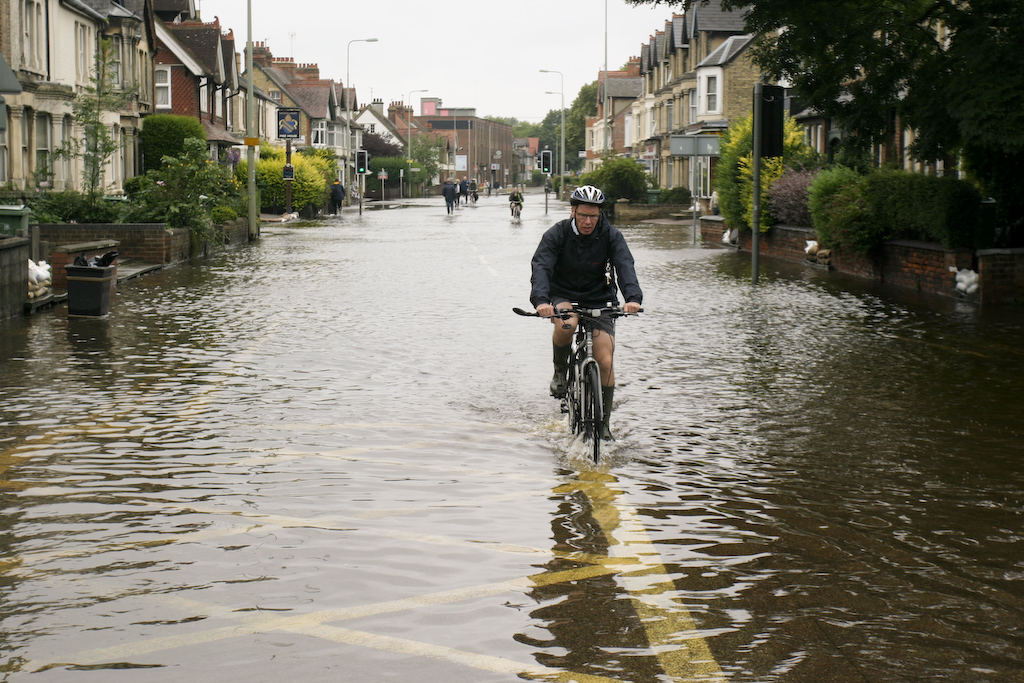
Paige Davies, a City-REDI Summer Intern, looks at the impact of flooding on households, business, transport, nature and health. Paige has recently graduated with a BSc in Geography and is about to begin a Masters in Environment, Development, and Politics at the University of Birmingham.
Climate change has been recognised as a global challenge, seeing warmer and wetter winters, hotter and drier summers, and an increase of extreme weather events, resulting in droughts, heatwaves, and flooding. By 2050, flooding will affect between 2.6-3.3 million people in the UK (Kovats and Osborn, 2016). In the Midlands, flooding poses a threat to households, health, businesses, transport infrastructure and the natural environment.
Households
Flooding is a threat to households due to urbanisation and population growth, resulting in people living in more densely populated areas. The average cost of flood damage to a home in the West Midlands is £30,000 (Environmental Agency, 2023), with Birmingham at greatest risk of flooding damages in the UK after London (Adedeji et al., 2019). The East Midlands has the third highest number of properties at risk of flooding in England, with over 200,000 properties and over 400,000 people living in flood risk areas (East Midlands Councils, 2015).
Urbanised areas with high deprivation levels remain the most vulnerable to flooding (Fig. 1).
Flooding also increases deprivation due to financial damages. After a flooding event, financial costs are high due to the need for household repairs, loss of employment (both temporarily and permanently), and increased utility costs (West Midlands Combined Authority (WMCA), 2022). This widens inequality, with those in areas of high deprivation at greatest risk of being unable to maintain these costs, worsening health issues (UK Health Security Agency, 2022). Furthermore, insurance policies often increase after a flooding incident, becoming unaffordable, and leaving households unprotected.
Figure 1. Areas of deprivation and flood risk in the West Midlands

Flooding can be managed in a variety of ways to reduce the impact on households. For instance, the construction of embankments and flood walls is the traditional albeit costly method to reduce flooding (Environment Agency, 2015). The Trent Left Bank Flood Alleviation Scheme in Nottingham is a £45 million scheme reducing the risk of flooding to 16,000 homes and businesses along a 27km stretch of the River Trent. The Tenbury Wells Flood Risk Management Scheme in Worcestershire reduces flood risk for 120 residential and 145 commercial properties by constructing flood walls and embankments. Natural methods should also be considered, such as the use of sedum roofing and sustainable drainage systems. The installation of sedum roofing is particularly useful in highly urbanised areas, retaining and slowing the release of heavy rainfall, while using no additional space, utilised by Nottingham Trent University (Climate East Midlands). Another method implemented in new housing developments is Sustainable Urban Drainage systems, which increases water storage capacity, reducing flooding (Environment Agency, 2021).
Health
Sandwell, Walsall, Wolverhampton, and Central Birmingham are at greatest risk of flood related health problems in the West Midlands, due to high deprivation levels (Fig. 1) (WMCA, 2022). Flooding events can cause morbidity, physical trauma, electrocution, as well as skin and gut infections from contaminated water, with access to healthcare reduced following a flooding event. After these events, health problems develop such as respiratory related disease due to damp and mould (WMCA, 2022), and increasing mental health problems, with those affected, or at risk of flooding reported to have increased anxiety, depression, and PTSD (Robin et al., 2020). Overall, flooding adds pressure to the NHS (East Midlands Councils, 2015), while exacerbating health inequalities.
Businesses
Flooding impacts businesses, with a single event disrupting supply chains and production time. This is especially problematic in the Midlands, which is dominated by manufacturing businesses such as Jaguar Land Rover. Flooding of industrial sites can create pollution problems, exacerbating impacts on health and nature. Flooding can also impact utility businesses, with the failure of just five of the region’s electricity substations predicted to cost the Midlands £27 million per day (WMCA, 2022).

The agricultural industry is also negatively impacted. For instance, flooding in the East Midlands in 2007 destroyed wheat, barley and rape seed crops, costing each farmer on average £500,000, impacting 55,000 homes and overall causing £3 billion worth of damages (Climate East Midlands). Flooding events in agricultural areas shorten growing seasons, reducing productivity due to reduced soil fertility and resulting in local and regional economic losses (Sustainability West Midlands, 2004). However, there are opportunities to develop flood resistant crops to be grown in the UK, which in the East Midlands it is predicted would reduce financial losses by 35-85% in Lincolnshire alone (Gould et al., 2020). Flooding also produces economic opportunities for businesses, with growth in investment and consultancy jobs across the region (East Midlands Councils, 2015).
Transport Infrastructure
Flooding threatens traffic infrastructure. Flooding of roads and public transport is more likely in areas with poor drainage systems, reducing traction on roads, especially in winter months, when flooding is most likely to occur. This increases pressure on public transport services when roads become unsafe. This is especially true for the East Midland rail service, which is at greatest flood risk of all railway networks across the UK, due to being at risk from not only surface and groundwater flooding, but coastal flooding as well (Pregnalato and Dawson, 2018).
There is a myriad of safety measures in place to protect roads from flooding impacts, such as enhanced drainage systems, increased monitoring to reduce drainage blocks, and increased greenery near the roadside, all requiring additional labour to complete (Highways England, 2016). To ensure railway services are not disrupted, similar mitigations should be put in place, including the use of naturally irrigating plants around railways, and water storage tanks, which can recycle water in stations for heating, as have been adopted in the construction of HS2 (Environmental Agency, 2021). Flooding also creates job opportunities in geotechnics, focusing on ground stability to determine the durability of roads, pavements and bridges.
Nature
The Midlands contains a wealth of flora and fauna, with rare habitats and species found across the region that are at risk in the event of a flood. Flooding can destroy both species and habitats in freshwater, terrestrial and estuarine habitats, altering the community makeup and resulting in reduced biodiversity. This can allow for new species to settle, many of which are invasive species, such as Himalayan Balsam (WMCA, 2021). Flooding will also cause a migration of estuarine species to freshwater habitats because of sea level rises, of which the floods increase the salinity of these habitats. By restoring habitats to their natural state, like the SUNRISE project, Stoke, the heterogeneity of the habitat will be maintained, while also providing flora coverage to alleviate flood damage by the absorption of water (SUNRISE).
Overall, flooding presents a variety of risks that impact the entire Midlands region directly and indirectly. Local governments across the region should assess flood defences and highlight areas and communities most at risk. To protect the Midlands from the long-term effects of flooding, funding for flood defences should be applied on a multi-year basis. Despite various job opportunities, flooding has a negative impact on the Midlands, putting pressure on the NHS, reducing business productivity, disrupting the transportation of goods, and causing damage to households and livelihoods.
This blog was written by Paige Davies, City-REDI Summer Intern, City-REDI / WMREDI, University of Birmingham.
Disclaimer:
The views expressed in this analysis post are those of the authors and not necessarily those of City-REDI or the University of Birmingham.
